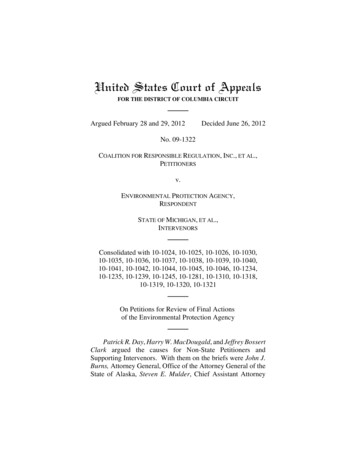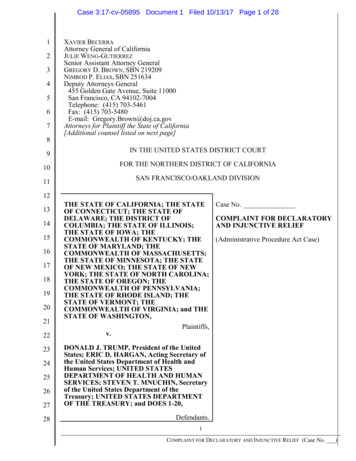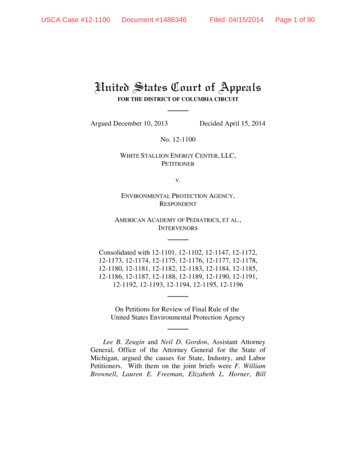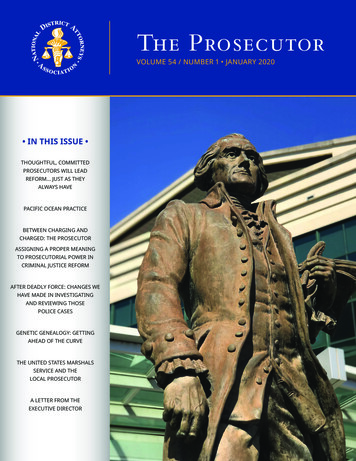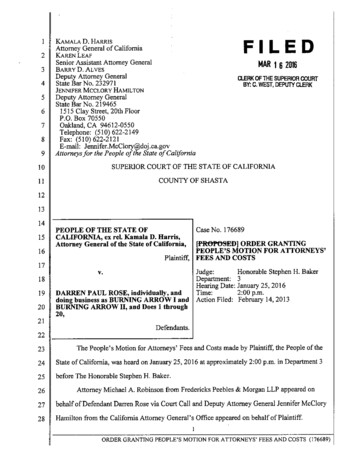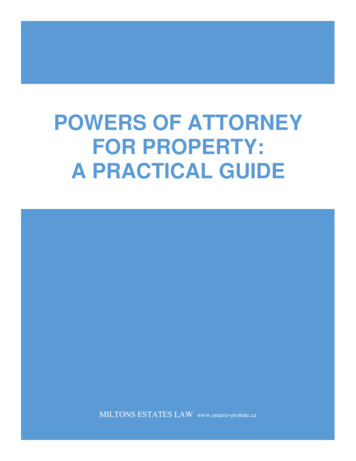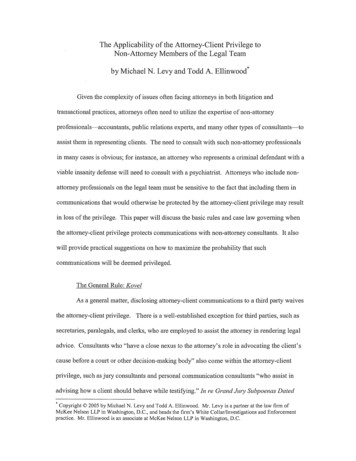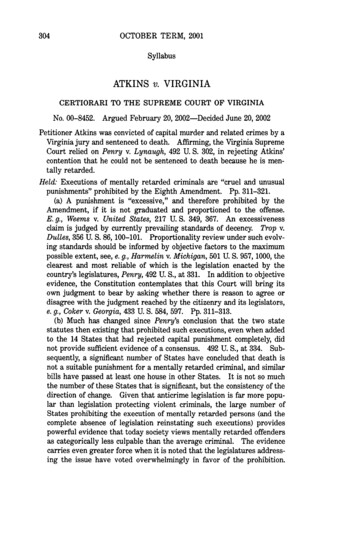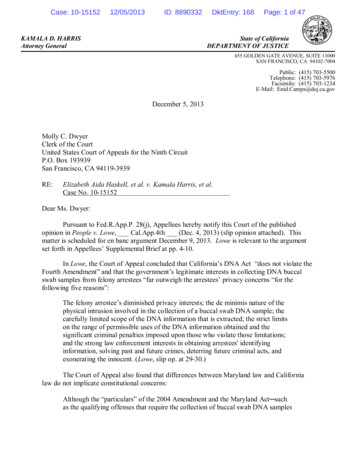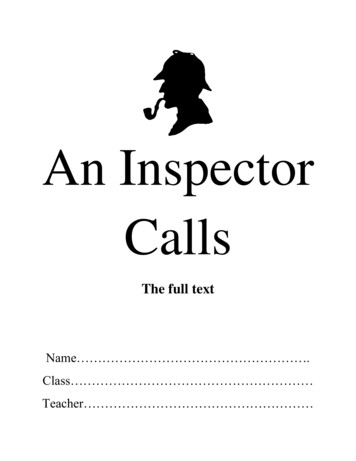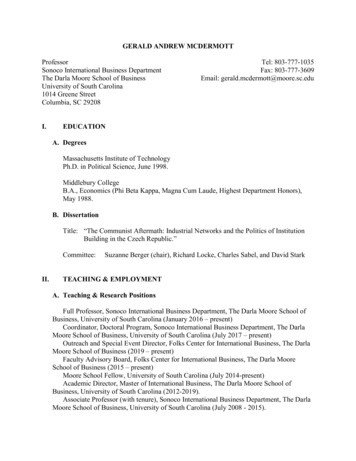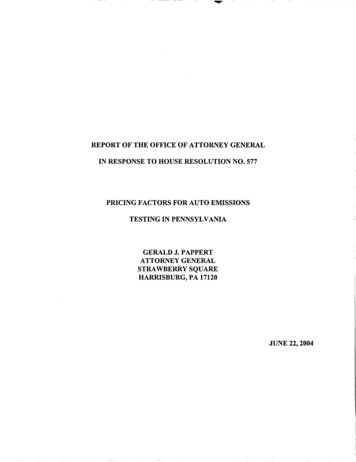
Transcription
1'%REPORT OF THE OFFICE OF ATTORNEY GENERALIN RESPONSE TO HOUSE RESOLUTION NO. 577PRICING FACTORS FOR AUTO EMISSIONSTESTING IN PENNSYLVANIAGERALD J. PAPPERTATTORNEY GENERALSTRAWBERRY SQUAREHARRISBURG, PA 17120JUNE 22,2004
I.BackProundA.Review of Emissions Testing by Office of Attorney GeneralMy Office conducted a review of the emissions inspection program in theCommonwealth pursuant to House Resolution No. 577. An attorney and investigator from myAntitrust Section contacted PennDOT and numerous emissions inspection station operatorsaround the Commonwealth to learn more about the emissions inspection program. Theyexamined these operators to determine whether emissions inspection stations engaged in anticompetitive collusive conduct concerning the price of the emissions inspection and whetheremissions inspection stations had knowledge of any other emissions inspection stations engagingin anti-competitive collusive conduct concerning the price of the emissions inspection, inviolation of the federal antitrust laws. My staff inquired about the costs incurred by theemissions inspection stations to purchase the necessary testing equipment; to have technicianscertified to perform the tests; and to perform an actual emissions inspection inclusive of all laborcosts and overhead costs. Furthermore, they questioned how long it takes to complete anemissions inspection; how each test is performed on vehicles from various model years; and howmany vehicles have failed the test and why they failed.B.The Reauirement for Emissions InspectionsEmissions inspections are not new to the Commonwealth. In the Philadelphia region,certain vehicles' have been subject to tiered and targeted emissions inspection requirements since1984. Likewise, emissions tests have been required in the Pittsburgh region since 1984. Bothregions introduced an enhanced auto emissions test in October 1997. A May 2003 settlement ofa lawsuit brought by public interest groups2resulted in auto emissions testing in some form forthe rest of the Commonwealth. The groups sued the Commonwealth because they alleged thatthe state was not taking steps to comply with the Clean Air Act in a timely manner.The application of emissions testing varies by regions in the Commonwealth. There arefive regions, each of which has different standards from other regions. The level of testing variesby region due to the unique set of environmental concerns and conditions for each region. Notonly is this approach used in emissions testing, but also it is used in setting the requirements forcertain types of gasoline, such as conventional, reformulated and oxygenated, which vary byregion due to environmental concerns and conditions.'Vehicles, as the term is used in this report, are defined as only being gasoline-powered,consistent with the present application of the emissions inspection programs in theCommonwealth.2Thepublic interest groups are Citizens for Pennsylvania's Future and the Clean AirCouncil.
C.Statewide Implementation of the Emissions Inspection ProgramThe Pennsylvania Department of Environmental Protection (“DEP”) and PennDOT havedivided the Commonwealth into five regions: Philadel hia, Pittsburgh: South Central,’Northern6 and Other Counties.’ The listing indicates those regions with the most environmentalconcerns, as identified by the Environmental Protection Agency, DEP and PennDOT, indescending order, based on the emissions testing and gasoline requirements for each region.Thus, DEP and PennDOT have devised a test program for each region that is appropriate for theneeds of each region. The settlement introduced three new emissions tests to Pennsylvania: thevisual anti-tampering test; the gas cap test; and the OBD2 diagnostic test. In the areas wheretesting has been required since 1984, inspections stations have been performing a tailpipe testand, since 1997, a tailpipe test using a dynamometer. The OBD2 diagnostic test is applicable inthe Philadelphia, Pittsburgh and South Central regions. The visual anti-tampering test iscommon in all regions. The gas cap test is applicable in all regions except the Other Countiesregion.3ThePhiladelphia region includes the following counties: Bucks, Chester, Delaware,Montgomery and Philadelphia.4The Pittsburgh region includes the following counties: Allegheny, Beaver, Washingtonand Westmoreland.’The South Central region includes the following counties: Berks, Cumberland, Dauphin,Lancaster, Lebanon, Lehigh, Northampton and York.6TheNorthern region includes the following counties: Blair, Cambria, Centre, Erie,Lackawanna, Luzerne, Lycoming and Mercer.7The Other Counties region includes the following counties: Adams, Armstrong,Bedford, Bradford, Butler, Cameron, Carbon, Clarion, Clearfield, Clinton, Columbia, Crawford,Elk, Fayette, Forest, Franklin, Fulton, Greene, Huntingdon, Indiana, Jefferson, Juniata,Lawrence, McKean, Mifflin, Monroe, Montour, Northumberland, Perry, Pike, Potter, Schuylkill,Snyder, Somerset, Sullivan, Susquehanna, Tioga, Union, Venango, Warren, Wayne andWyoming.-2-
D.TheTestsThe visual anti-tampering test is designed to ensure that certain emissions equipment3 ispresent on the vehicle. This test involves putting the vehicle up on the rack to permit thetechnician to verify the presence of all required equipment on the vehicle. This test is generallyrequired on vehicles that are 1995 and older. The test does not, however, rate the operationalefficacy of the required emissions equipment.The gas cap test is required in all regions except Other Counties. It tests the integrity ofthe gas cap, making sure it seals properly to prevent the escape of harmful fumes. The test isperformed by removing the gas cap from the vehicle, fitting it on the test equipment andsubjecting it to pressure for 45 seconds. Operators contend that the overwhelming majority offailures are due to bad gas caps. Oftentimes, this can be remedied by tightening the gas cap untilit clicks a few times and the vehicle will pass.The OBD2 test is performed in the Philadelphia, Pittsburgh and South Central regions.This test is applicable to vehicles that are 1996 and newer. Of note, 61.O%, 61.7% and 55.2% ofthe total vehicles registered in the Philadelphia, Pittsburgh and South Central regions,respectively, are 1996 and newer. Diagnostic software analyzes the performance of the ignition,fuel metering and emissions systems. Vehicles subject to this test have an OBD2 port that isgenerally found under the dashboard on the driver’s side. Operators connect a wire between theOBD2 port and the personal computer running the OBD2 diagnostic software. Generally, allvehicles that have the “check engine” light activated on their dashboards when presented for thetest will fail the test. Occasionally, the check engine light can be triggered by a failure toproperly tighten the gas cap. Operators can use their shop scan tools to diagnose the problem forrepair.The enhanced safety inspection is performed only in the region known as Other Counties.This test is applicable to most vehicles weighing 11,000 lbs and less. In this region, the statesafety inspection is augmented by a visual anti-tampering test. Only one sticker is applied to thewindshield. Again, the emissions equipment on vehicles in this region is not tested foroperational efficacy but, rather, to ensure that the equipment is present.There are other tests that are still being performed in the Pittsburgh and Philadelphiaregions. These are the tailpipe test and the tailpipe test using a dynamometer, respectively. Thetailpipe test involves idling the engine while inserting an emissions analyzer in the tailpipe for30-45 seconds. In the Pittsburgh region, 1975-1995 model year vehicles are subject to thetailpipe test. In the Philadelphia region, 1981-1995 model year cars and 1984-1995 model yearlight-duty trucks are also subject to the tailpipe test using a dynamometer. This test involves‘The equipment verified are the catalytic converter, exhaust gas recirculation valve,positive crankcase ventilation valve, fuel inlet restrictor, air pump and evaporative control systemcomponents.-3-
setting the vehicle’s drive wheels on a treadmill-like device &e., the dynamometer), running thevehicle at 15 miles per hour while inserting an emissions analyzer in the tailpipe for 30-45seconds. The dynamometer is not used to test the emissions of 1975-1980 model year cars and1975-1983 light-duty trucks in the Philadelphia region. In all cases involving either a tailpipetest or a tailpipe test using a dynamometer, the visual anti-tampering test and the gas cap test arealso performed.11.Emissions Tests PricinyHouse Resolution No. 577 was prompted by numerous consumer complaints about thehigh cost of emissions tests. In January 2004, PennDOT estimated the cost to operators ofperforming the test was 13.76. This estimate of costs was based on the allocated cost of labor,equipment, program management fee, training and the dedicated phone line. With this coststructure, PennDOT believed operators would charge 25 to 30 for emissions tests. Whenoperators in the South Central region starting charging 50 or more for this test, consumerswanted to know why the tests were so expensive and whether the high prices were set bycollusion among operators.In general, emissions testing is more expensive than PennDOT predicted becauseoperators have actual or perceived costs that are greater than PennDOT estimated. Two principalfactors drive those costs: the time it takes to perform the tests and costs associated with thetesting equipment. The cost analysis prepared by PennDOT did not include the allocation ofoverhead costs including, but not limited to, mortgage, rent, utilities, insurance, taxes, back officesalaries, service contracts, bank fees, credit card processing fees and building maintenance.These costs are ordinarily allocated to all services that the operators provide.Since the expansion of the emissions testing program, consumers have had the choice oftaking their vehicle to an emissions inspection station based on shopping around for the bestprice using the Drive Clean PA website.’A.Cost StructureWe interviewed 25 emissions inspection stations about their emissions testing experience,practices and pricing decisions. The regions were selected so that some stations with each typeof testing regime would be interviewed. Interview subjects were either randomly sampled orspecifically selected to investigate allegations of collusion. The Office has received allegationsthat specific operators in specific geographic areas were colluding. Operators in each such areawere contacted.’The website URL is http:\\www .drivecleanpa.state.pa.us.-4-
Most operators seek to recover their costs of performing an emissions test. They do notuse the test as a promotion to attract customers like some operators do for the safety inspectionswhich often generate other billable work. Generally, the emissions test does not result in extrabillable work. Therefore, the operators have less of an incentive to discount the emissions testthan they have for safety inspections. The fail rate for emissions tests is less than two percent.During our interviews, some operators told us that they can count on one hand the number of carsthat have failed the emissions testing in the six months it has been required.Many, if not most, operators based their price for the emissions tests on the cost of labor,cost of the equipment plus overhead costs. PennDOT estimates that the typical operator shouldtake 12 minutes to perform the test. According to the operators we interviewed and the actualtests this Office observed, the time to perform the test was significantly greater. In fact,PennDOT’s own demonstration emissions test took significantly longer because of an equipmentcommunication failure. Absent any issues that may delay the process,1ooperators reported thatthe tests take approximately 30 minutes to complete. This Office witnessed two tests byoperators, as well as PennDOT’s own demonstration test. None of these tests took less than 20minutes. Two of the tests took 30 minutes. The reasons for the discrepancy betweenPennDOT’s estimate and the operators’ estimate include: physical set up of many shops whichrequires moving a variety of machines or vehicles in order to get the testing equipment intoplace; operators’ inexperience with testing equipment; communication” problems between thetesting equipment and PennDOT’s computers; and differences in the location of the OBD2 portin different vehicles.Our sample survey of the emissions inspection stations showed that the average labor ratefor services is approximately 55 per hour. In the sample, there were stations that charge up to 80 per hour. This means the labor price along for a typical test is around 25.Another factor in the cost of the emissions test is the testing equipment. Operatorscomplain about having to purchase a personal computer system loaded with Pennsylvaniaspecific software for a cost of 5,000 to 10,000.’* Operators in the Philadelphia region paidbetween 45,000 and 50,000 for a dynamometer in 1997 that is expected to be phased out overtime as the OBD2 test becomes the dominant test.I3 Operators in the Philadelphia region point“An example of a delay is having to perform a “drive cycle” to get the vehicle ready fortesting.“These problems could be caused by the operators’ telephone lines or the type of modemused.‘*ThisOffice reviewed actual invoices from suppliers to operators for the equipment.13Someoperators in the Philadelphia region have reported that 75% of the vehicles testedare presently subject to the OBD2 test, meaning that most of their customers’ vehicles are 1996-5-
out that they were told by PennDOT that the personal computers used with the dynamometerwould be upgradeable for use with the OBD2 test for much less than having to pay for a newOBD2-dedicated personal computer workstation. Instead, the operators had to purchase separateworkstations for the OBD2 test.PennDOT's cost estimates were based on a three-year amortization schedule consistentwith the three-year term of the settlement agreement and with generally accepted accountingprinciples. Under federal tax law, a significant capital expenditure may be amortized over theexpected life of the equipment. The expected life of the OBD2 equipment is five years, but mostof the dealers we interviewed had several reasons for amortizing the cost of the equipment over aone-year period. First, whatever amortization schedule may be appropriate, the purchase of thesemachines meant a significant cash outflow this year that operators, especially small operators,need to recoup. Second, the core of the OBD2 workstation is a personal computer whichgenerally will become less valuable quickly as prices of personal computers decline. Third, thereis considerable uncertainty about whether the testing standards will be changed by futurelitigation over Pennsylvania's compliance with the Clean Air Act. The experience of thePhiladelphia area operators with the purchase of expensive dynamometers fuels this uncertainty.For many operators, overhead is a significant expense. Not every car requires the OBD2test. While the new car dealers and chain service locations might do 10-20 tests a day, manysmaller neighborhood garages14were doing three to five tests. In theory, it might make sense foronly those garages which do many emissions tests to purchase the equipment. However, nogarage that does safety inspections can afford to refuse to offer the emissions test. To do sowould mean referring a customer to a competitor for the first part of the annual inspection orsubcontracting the testing to someone else. Neither alternative is very attractive to garages, andconsumers would not want more stops to have their cars inspected. An emissions inspection is aprerequisite for the state safety inspection.B.Business FormatA review of the prices demonstrated that certain inspection stations charge more for theemissions test. For example, emissions inspection stations based at new car dealerships maycharge more because the labor rate at the service departments is typically higher. Inspectionstations at a garage that has a very good reputation; a well-maintained facility; and, acorrespondingly high labor rate are likely to charge a higher emissions test fee.Alternatively, pricing at franchised service facilities was lower. Such facilities rely uponvolume to make up for the low price. With a higher volume, the likelihood increases that aand newer.14One garage owner we interviewed pointed to a whole service bay that was occupied by alargely unused dynamometer.-6-
vehicle will come in that required some other service or parts. Those other services or parts mayhave nothing to do with the emissions equipment on the vehicle. A low price may also be usedto drive business to the franchised service facility for other products, such as tires, batteries ormufflers and services by having created the impression that the facility generally prices lowerthan others.The price of the emissions test at independent neighborhood repair facilities may varyfrom low to high depending on the facility's unique cost structure.111.CollusionHouse Resolution No. 577 was prompted, in part, by allegations that high emissiontesting fees resulted from collusion among inspection station operators. Unlawful collusionunder the federal antitrust law occurs when two or more competing businesses agree to fix orstabilize prices. The key to proving collusion is proving an agreement. A unilateral decision bya business to charge high prices is not unlawful. My Office found no evidence of widespreadcollusion among inspection station operators. In fact, the variety of prices available in mostcommunities and the general reduction in prices which has occurred since the tests initially wererequired, suggests the opposite. We cannot say, at this time, that there is no collusion in settingprices in specific local communities. We have not reviewed the price practices in each localcommunity. There have been allegations of several instances where groups of three or fouroperators have met and agreed on emissions testing fees. We are in the process of reviewing theevidence in specific communities where there is some claim that prices have been set bycollusion. We will report back to the General Assembly should we find enough evidence towarrant action.This Office learned through its questioning of a number of operators that they hadcontacted other operators to survey pricing. Such conduct is not actionable under the federalantitrust laws. Surveying has been further facilitated by DEP and PennDOT via the Drive CleanPA website. Most operators acknowledged using the Drive Clean PA website to learn of theircompetitors' pricing. A service station organization circulated a warning to operators of thepotential antitrust consequences of discussing prices for the purpose of restraining trade.''"The document is attached as Exhibit 2.-7-
IV.Recommendation for Legislative ChanFesThe House of Representatives requested:[tlhat the Attorney General of the Commonwealth investigate the possibility ofcollusion among the garage owners in the establishment of their emissions testingfees and whether there may be any violation of the Unfair Trade Practices andConsumer Protection Law or any other statutes . . . I 6H.R. 577,2003-2004 Regular Session (2004).The resolution also states:[tlhat the Attorney General report the progress of the investigation to the House ofRepresentatives within 90 days following the adoption of this resolution,including any recommendations for legislative changes necessary to provideconsumer relief and protection . . .H.R. 577,2003-2004 Regular Session (2004).This Office does not have specific recommendations for legislation. Prices aremoderating as more consumers use PennDOT’s Drive Clean PA website and garages becomemore experienced. Although PennDOT estimated that the price for the test was significantlylower than most consumers have experienced, accurately estimating prices of a new service in amarket where several different business models compete (ie., new car dealership, neighborhoodgarage and franchised service center) is difficult.V.ConclusionThe review undertaken by this Office in response to the request by the House ofRepresentatives found no evidence sufficient to support a violation of the federal antitrust fair Trade Practices and Consumer Protection protects consumers from fraud anddeceptive business practices. Romeo v. Pittsburgh ASSOC.,787 A.2d 1027, 1033 (Pa. Super.2001), appeal denied, 797 A.2d 915 (Pa. 2002). The law is devoid of any provision to protectconsumers from collusive anticompetitive conduct. Yeacer Fuel’s. Inc. v. Pennsylvania Power &Light Co., 953 F. Supp. 617,668 (E.D. Pa. 1997). Any action for collusion would have to bebrought under the federal antitrust laws.-8-
fcPRINTER'S NO.PRIOR PRINTER'S NO. 33403472THE GENERAL ASSEMBLY OF PENNSYLVANIAHOUSE RESOLUTIONNo.577Session of2004INTRODUCED BY GEIST AND McCALL, MARCH 8, 2004 AS REPORTED FROM COMMITTEE ON TRANSPORTATION, HOUSE OFREPRESENTATIVES, AS AMENDED, MARCH 17, 2004A RESOLUTION123456789Requesting the Attorney General of the Commonwealth toinvestigate the possibility of collusion in the establishmentof fees within this Commonwealth as it pertains to motorvehicle emissions testing and any potential violations of theUnfair Trade Practices and Consumer Protection Law; anddirecting the Legislative Budget and Finance Committee toprepare a report on the actual costs incurred by emissioninspection stations.WHEREAS, In 2002, Citizens For Pennsylvania's Future10(PennFuture) and the Clean Air Council initiated two lawsuits11over the Commonwealth's slow progress in implementing auto12emissions inspection procedures mandated by the Environmental13Protection Agency; and14WHEREAS, In May 2003, the Department of Transportation and15the Department of Environmental Protection announced an16agreement to settle these lawsuits over Pennsylvania's program17for automobile emissions testing. The changes called for in this18agreement bring the State's emissions testing program into19compliance with Federal air quality standards while having a20minimal effect on most of the State's drivers; and
WHEREAS, The Commonwealth has begun to implement emissionstesting changes by expanding the test to additional countieswithin this Commonwealth where emissions testing did notpreviously occur; andWHEREAS, The garages conducting the emissions tests are leftto establish their own fees; andWHEREAS, The garages in the Philadelphia and Pittsburgh8regions have been conducting emissions testing for over ten9 years with an average fee for such tests of between 2 8 and 44.10 These fees are based on equipment purchased at a cost of11 approximately 16,000 to 60,000; and12WHEREAS, The garages in the counties where emissions testing13 was initiated in December 2003 are charging consumers anywhere14from 20 to 70. These fees are based on equipment purchased at15 a cost of approximately 5,000 to 8,000; and16WHEREAS, Media reports have shown that garage owners in the17 expanded regions have communicated with one another in order to1819establish fees; andWHEREAS, Consumers may be experiencing artificially high fees20for emissions testing as a result of complicity among the21garages; therefore be it22RESOLVED, That the House of Representatives request that the23 Attorney General of the Commonwealth investigate the possibility24of collusion among the garage owners in the establishment of25their emissions testing fees and whether there may be any26 violation of the Unfair Trade Practices and Consumer Protection27Law or any other statutes; and be it further28RESOLVED, That the Attorney General report the progress of29the investigation to the House of Representatives within 90 days30following the adoption of this resolution, including any20040H0577R3472- 2 -
1recommendations for legislative changes necessary to provide2consumer relief and protection; and be it furtherRESOLVED, That the Legislative Budget and Finance Committee34study and issue a report on the actual costs incurred by5emission inspection stations for the performance of emissions6tests implemented after November 30, 2003. In preparing this7study, the Legislative Budget and Finance Committee shall8consider the cost of the testing equipment as well as other9factors such as the total amount of time necessary to complete10the test, APPROPRIATE OVERHEAD AND OTHER COSTS OF DOING11BUSINESS; and be it further12aRESOLVED, IN REVIEWING THE COST OF TESTING EQUIPMENT, THAT13THE LEGISLATIVE BUDGET AND FINANCE COMMITTEE REPORT ON THE14REASON FOR THE SIGNIFICANT DIFFERENCES BETWEEN INITIAL15DEPARTMENT OF TRANSPORTATION ESTIMATES OF 750- 1,200 AND16 2,500- 7,000 PER UNIT AND THE 5,000- 7,000 PER UNIT COST FOR17EQUIPMENT AS FINALLY CERTIFIED BY THE DEPARTMENT; AND BE IT18FURTHER19RESOLVED, That the Legislative Budget and Finance Committee20submit its report to the Transportation Committee of the House21of Representatives within 120 days following the adoption of22this resolution.- 3 - -
.'IIT IS UNDERSTOODTHAT IN TODAY'S SESSION,WE WILL NOT DISCUSS ANY ISSUES WHICH WOULDVIOLATE ANTITRUST GUIDELINES.ANTITRUST GUlDELlNESAVOIDING VIOLATIONS OF THE ANTITRUST LAWS ISTHE RESPONSIBILITY AND LEGAL OBLIGATIONOF THE BUSINESS OWNER.ANY DISCUSSION OF CURRENT PRICES OR DISCOUNTSWITH A COMPETITOR SHOULD BE AVOIDED. IN OURINDUSTRY, THIS INCLUDES DISCOUNTS, TIME, HOURLYRATES CHARGED TO INSURANCE COMPANIES,INDIVIDUALS, FLEET OWNERS, DEALERSOR OTHER SHOPS FOR REPAIRING VEHICLES.SURVEYS OF PRICES, DISCOUNTSAND COSTS AREPERMISSIBLE BUT ONLY UNDER STRICT GUIDELINESAND ONLY IF THEY ARE NOT PART OF A CONSPIRACYTO FIX PRICES OR TO OTHERWISE RESTRAIN TRADE.COST STUDIES, WHICH LEAD TO PRICE FIXING ORPRICE-STABILIZING AGREEMENTS VIOLATE THEANTITRUST LAWS.REMEMBER, THE PRICES CHARGED MUST BECALCULATED AND DETERMINED BY THE BUSINESSOWNER ALONE. THESE PRICES SHOULD TAKE INTOACCOUNT THE COST OF DOING BUSINESS AND INCLUDEALLOWANCES FOR REASONABLE PROFIT.Exhibit 2
B. The Reauirement for Emissions Inspections Emissions inspections are not new to the Commonwealth. In the Philadelphia region, certain vehicles' have been subject to tiered and targeted emissions inspection requirements since 1984. Likewise, emissions tests have been required in the Pittsburgh region since 1984. Both
